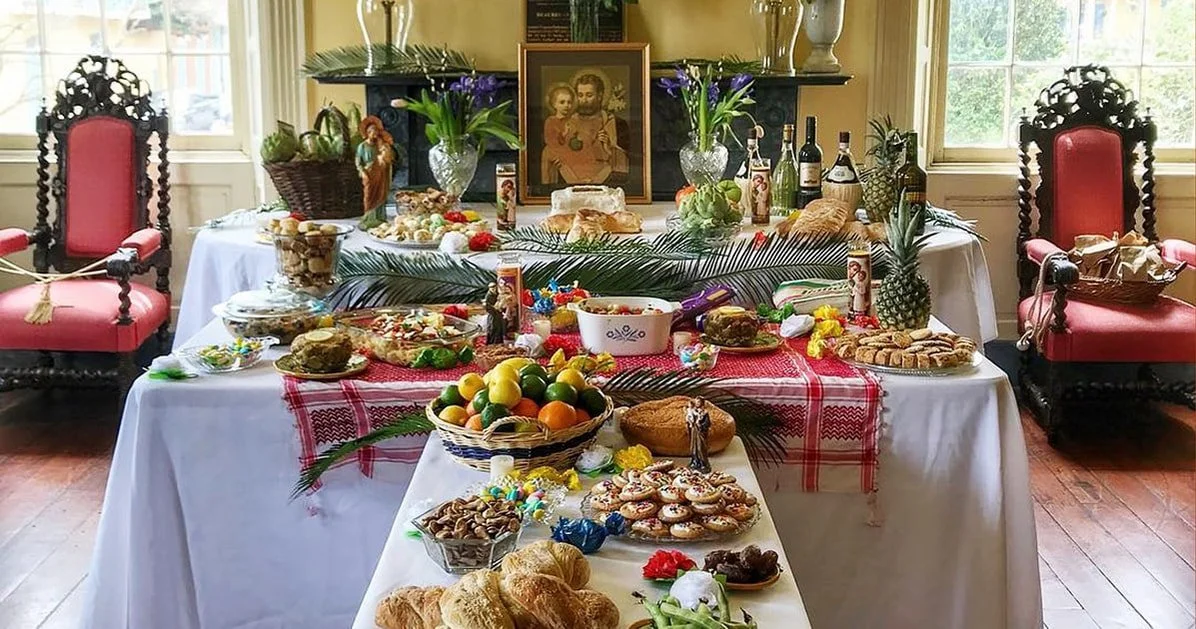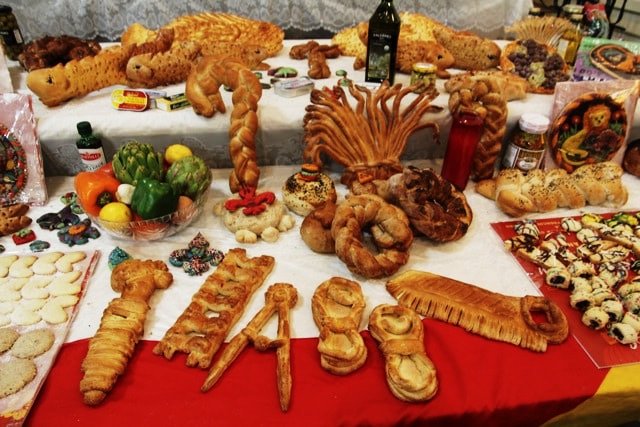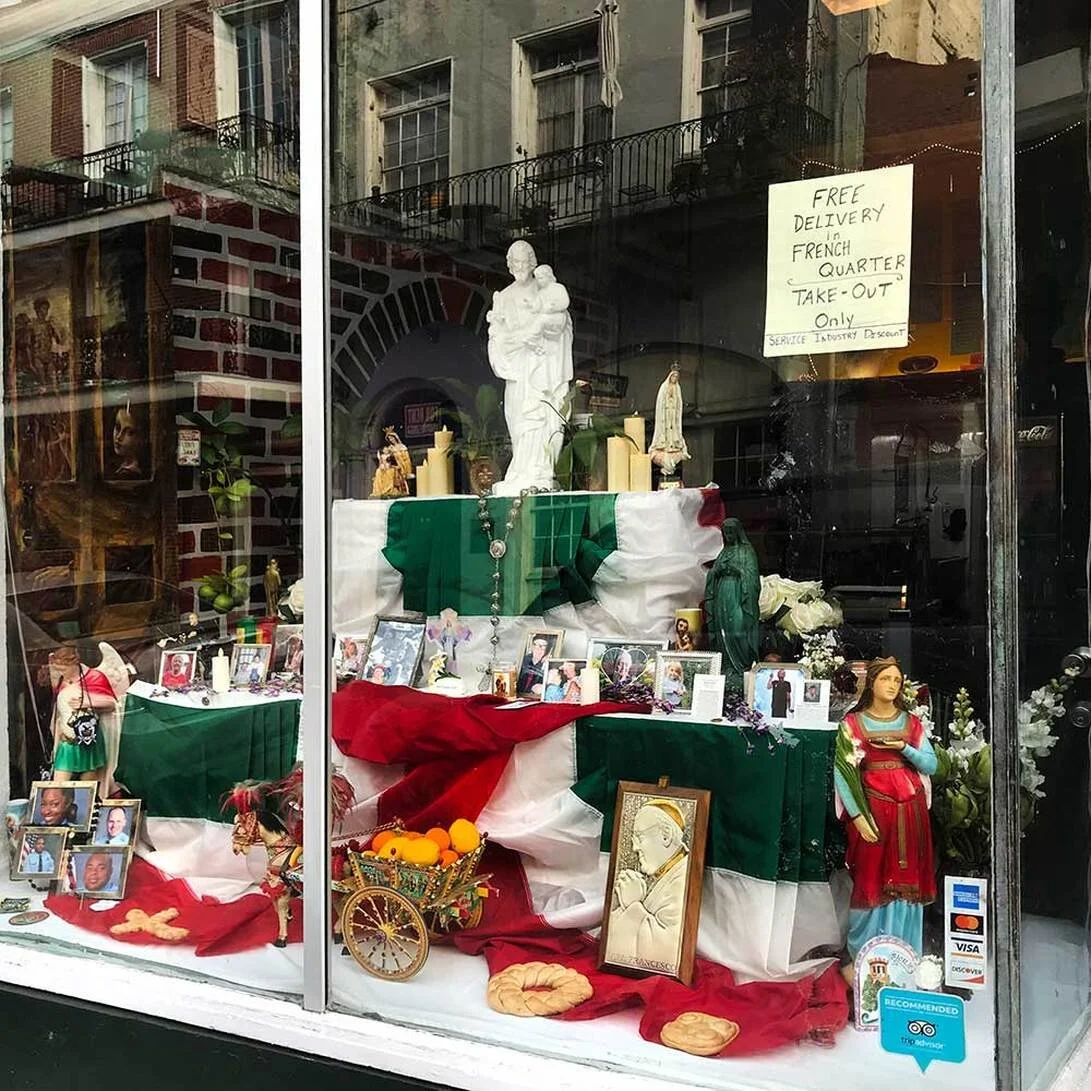Famine to Feast
Altar to St. Joseph at the Beauregard-Keyes house on Chartres Street. photo courtesy B-KH
March 2020If you can't feast at a celebration this St. Joseph's Day, at least you can feast your eyes with a virtual visit to three different St. Joseph's altars in the Quarter.
-By Reda Wigle
Catholics, myself among them, tend to deal in decadence and deprivation. True to form, the St. Joseph’s Day Altar is an abundant offering for an answered prayer.
The origins of the altar trace back to Medieval Sicily when a devastating drought dried crops and leveled livestock. The Sicilian faithful prayed to St. Joseph for mercy and were rewarded with rain. To honor Joseph’s divine intervention, they prepared an altar on his feast day, laying communal tables and offering food and fellowship to the poor.
Generations later, a mass migration of Sicilians made their way to the drought-less city of New Orleans, carrying with them the tradition of the altar.
Beauregard-Keyes House
2020 event canceled
photo courtesy B-KH
One such family was the Giaconas, whose patriarch, Corrado, immigrated in the early 1900s with his entire extended family. They lived at 1113 Chartres, in what is now known as the historic Beauregard-Keyes House. Though their last name may not adorn the landmark building, the Giaconas lived in the home and performed the rituals of faith and family for a quarter century - the longest tenure of any that occupied the home before or since.
When Giacona’s granddaughter, Rosanna Giacona Shepherd, became a docent at the Beauregard-Keyes House, she began telling stories about her family and the tradition of the St. Joseph’s Day altar.
“I’m not an expert, I just experienced it,” explained Giacona Shepherd.
She remembers in particular the presence of some superstitious citrus. “Lemons were placed in a bowl on the altar with the belief that if you stole a lemon, you’d find someone to love. But you had to steal it, you couldn’t ask for it.”
Tradition holds for Giacona Shepherd and others that no stealing for the sake of love or eating for the sake of desire take place before a Catholic priest blesses the altar.
“To be honest with you that was the worst part, waiting for the priest and the prayers to be over,” she said with a laugh. “How many Hail Marys can you say?”
Because the feast day falls during the Catholic season of lent, meat is noticeably absent from the table. According to lore, the fava bean was the crop that kept Sicilians alive during the medieval drought and as such is revered as a symbol of fortune and survival.
While the lucky legume can be found on virtually every St. Joseph’s Day altar in the city, many keep one close at hand throughout the year. As Giacona Shepherd remembered, “my mother never left the house without a fava bean in her pocket.”
The intimacy of Giacona Shepherd’s knowledge and the richness of the hidden history of her family inspired the Beauregard-Keyes House to create their own St. Joseph’s Day altar in 2016. According to Lily Elkins, Education & Outreach Manager for the Beauregard-Keyes House, the revival of the altar is meant to honor not just the Giaconas but also the Sicilian legacy of the neighborhood at large.
“We have such a significant and recently discovered Sicilian heritage associated with the house,” she said. “We wanted to understand and observe the sacred nature of the altar and also call attention to its historical significance to the house and the neighborhood.”
As Elkins noted, the presence and influence of Italians in New Orleans was so greatly felt that the French Quarter was once known as Little Palermo. A reverence for the past and an eye towards inclusivity are the guiding principles of the Beauregard-Keyes altar.
“We want to do it in the right way and also widen the scope to people who may not know about the tradition.”
In terms of unorthodox additions to the altar, Elkins takes a progressive stance. “As long as no rules are broken, we are open to different items. Someone dropped off a bottle of Manischewitz last year and that was just fine,” she recalled with a laugh.
St. Augustine's Church
2020 event canceled
Those first Sicilian immigrants to New Orleans found fellowship just north of the Quarter at St. Augustine’s Church. The oldest African American parish in the country was reportedly also the first, and for a time, the only Catholic church in the city that welcomed Sicilians to worship.
“As it was being constructed and through to today, everyone was welcome, all nationalities,” explained Linda Harris, parish secretary for St. Augustine Church.
The braiding of Sicilian and African American communities and customs continued into the pre-war period of the 20th century. Unable to secure permits to parade, Mardi Gras Indians began masking amid the crowds and feasting of St. Joseph’s night. The revelry allowed the Indians to take part in the traditions of their Sicilian neighbors while discreetly honoring their own.
St. Augustine Church continues the spirit of cultural communion with the annual building of a St. Joseph’s Day altar. “The altar is an offering of love, work, and sacrifice,” said Harris.
This year, the altar will be open for viewing at eleven and blessed by Father Emmanuel Mulenga at noon. Amid health concerns related to the Coronavirus, the church has decided to cancel their courtyard feast for this year.
Plagues and pestilence notwithstanding, musician David Roe is continuing to honor his ancestry and community by baking for the church’s St. Joseph’s Day altar. “We’ve already taken two truckloads over,” he reported.
Roe, who describes himself as culturally Catholic, has a particular affinity for St. Joseph. “He was Jesus’s stepfather and he volunteered to raise him with the mentality that it takes a village. He was a carpenter and the patron saint of the working man. On the altar we’ll have bread baked into the shapes of all of his tools: a square, a compass, a hammer, a saw, and a ladder, and you scatter the breadcrumbs like sawdust.”
Roe starts baking three weeks in advance using recipes he inherited from his Sicilian grandmother. He began contributing to St. Augustine at the behest of heaven-sent, hell-raising Kathleen Barrow.
“She was the mother of everyone on Decatur Street. She barricaded herself in the church with some other ladies when the diocese tried to shut them down the year after Katrina. They had their food dropped in through windows.”
The renegade spirit of Barrow is reflected in the work of Roe and his Krewe, The Société Des Champs Elysée, who practice the pillar of charity by feeding the working poor at St. Mark’s United Methodist Church. With the current COVID-19 situation, Roe believes the number of those will rise.
“That’s what I’m doing with the last part of my life, I’m feeding people,” the musician said. For Roe, not even the threat of Coronavirus can keep him from his latent mission. “If it kills us, it kills us, but we’re going to feed the people.”
The altar at the St. Augustine Church, like most in the city, is three-tiered, symbolic of the holy trinity. Each tier also represents the different purposes of the altar - veneration, celebration and charity respectively.
Newton's Hot and Cold
on display in the window at 509 Dumaine Street
Those principles are on full display at Newton’s Hot and Cold where third generation Sicilian-American Vic Caracci transforms the café’s bay windows into a feast for all senses. Caracci bakes relentlessly for the altar and offers goodie bags to visitors.
The team at Newton’s Hot and Cold all previously worked at Caracci’s Toulouse Street eatery, Little Vic’s, helping him build an enormous altar to St. Joseph in the building’s courtyard each spring. When Caracci closed Little Vic’s two years ago, the crew threw in together to open their own cafe on Dumaine Street.
Caracci gave his blessings and his recipes to the new venture. His family memorabilia, both sacred and secular, serves as décor. Although the new location lacks the expanse of a courtyard, the Newton’s team gives over their large display window and helps Vic bake and decorate for the occasion.
Caracci and Newton’s kitchen manager Matthew Condon have a special way of paying tribute to the neighborhood they serve.
“We include photos of people that we’ve lost that we still want with us. I’ve invited all of our regulars to bring photos of their own for the altar,” said Condon. The veneration and remembrance of the dead is apropos of the feast day.
Vic Carraci working on the altar at Newton's.
Jelly Sandwich (R) on the altar.
As Caracci explained, “St. Joseph is the patron saint of happy death. It’s an opportunity to remember and pray for your loved ones.”
For their part, Condon and Caracci will be remembering a very special regular of their own. “This year we’ll be celebrating the memory of one of our favorite regulars, Jelly Sandwich, who we lost this year,” said Condon. “She was a riot. I’ve never met anyone so colorful - and that’s a lot to say in this town. We’ll be putting out signature jelly earrings on the altar in her honor.”
From sawdust crumbs and jelly earrings to Manischewitz and lover’s lemons, the altars of St. Joseph are meal and memory, set for the living and the dead, to honor an answered prayer and remind us all to keep a place for each other at the table.
Two other St. Joseph's altars in the French Quarter to look for in the future are the ones at Irene's restaurant on Bienville Street and the Marino family's on Bourbon Street.
Features like this are made possible by reader support–We're grateful for every donation –Join our Readers’ Circle with gifts as small as $5















